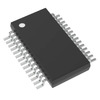Manufacturer Part Number
PIC18F4320-I/ML
Manufacturer
Microchip Technology
Introduction
The PIC18F4320-I/ML is an 8-bit microcontroller from Microchip Technology, designed for advanced level applications requiring extensive input/output operations and superior processing speed.
Product Features and Performance
Core Processor: PIC
Core Size: 8-Bit
Speed: 40MHz
Connectivity Options include I2C, SPI, UART/USART
Contains Peripherals like Brown-out Detect/Reset, Low-Voltage Detect, Power-on Reset, PWM, and Watchdog Timer
36 number of Input/Output pins
Program Memory Size of 8KB
FLASH Program Memory Type
EEPROM Size: 256 x 8
RAM Size: 512 x 8
A/D Converters: 13 channels, 10 bits each
Internal Oscillator
Product Advantages
High performance with 40MHz operational speed
Extensive connectivity for enhanced interfacing
Large number of I/O for versatile applications
Integrated analog features with multiple A/D converters
Key Technical Parameters
Speed: 40MHz
Program Memory Size: 8KB
Program Memory Type: FLASH
RAM Size: 512 x 8
Voltage Supply (Vcc/Vdd) from 4.2V to 5.5V
Operating Temperature range from -40°C to 85°C
Quality and Safety Features
Brown-out Detect/Reset
Low-Voltage Detect
Power-on Reset
Watchdog Timer for reliable system operation
Compatibility
Compatible with surface mount technology for easy PCB assembly
Utilizes the 44-QFN package that is common in embedded design
Application Areas
Industrial automation
Consumer electronics
Automotive systems
Communication systems
Product Lifecycle
Currently active product available for new designs and projects
Not nearing discontinuation, ensuring long-term availability
Several Key Reasons to Choose This Product
High-speed operation at 40MHz beneficial for real-time applications
Extensive EEPROM and FLASH memory for complex applications requiring data storage
Low power consumption with operation possible over a range of 4.2V to 5.5V
Suitable for harsh operating conditions with temperature tolerance from -40°C to 85°C
High level of integration reduces additional component needs and system complexity




 PIC18F4221-I/PMicrochip
PIC18F4221-I/PMicrochip PIC18F4320-I/PMicrochip TechnologyIC MCU 8BIT 8KB FLASH 40DIP
PIC18F4320-I/PMicrochip TechnologyIC MCU 8BIT 8KB FLASH 40DIP